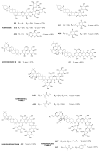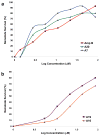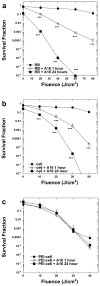Characterization of plant-derived saponin natural products against Candida albicans
- PMID: 20099897
- PMCID: PMC2965462
- DOI: 10.1021/cb900243b
Characterization of plant-derived saponin natural products against Candida albicans
Abstract
Candida albicans is an opportunistic fungal pathogen capable of life-threatening disseminated infections particularly in immunocompromised patients. Resistance to many clinically used antifungal agents has created a need to identify and develop a new generation of compounds for therapeutic use. A compound screen to identify potential antifungal natural products was undertaken, identifying 12 saponins, some of which have not been previously described. In the Caenorhabditis elegans model, some saponins conferred nematode survival comparable to that of amphotericin B. Of the 12 antifungal saponins identified, two were selected for further analysis. C. albicans isolates were inhibited by these compounds at relatively low concentrations (16 and 32 microg mL(-1)) including isolates resistant to clinically used antifungal agents. C. albicans hyphae and biofilm formation were also disrupted in the presence of these natural products, and studies demonstrate that fungal cells in the presence of saponins are more susceptible to salt-induced osmotic stress. Although saponins are known for their hemolytic activity, no hemolysis of erythrocytes was observed at three times the minimal inhibitory concentration for C. albicans, suggesting the saponins may have a preference for binding to fungal ergosterol when compared to cholesterol. Importantly, when used in combination with photosensitizer compounds, the fungus displayed increased susceptibility to photodynamic inactivation due to the ability of the saponins to increase cell permeability, thereby facilitating penetration of the photosensitizers. The large proportion of compounds identified as antifungal agents containing saponin structural features suggests it may be a suitable chemical scaffold for a new generation of antifungal compounds.
Figures





References
-
- Edmond MB, Wallace SE, McClish DK, Pfaller MA, Jones RN, Wenzel RP. Nosocomial bloodstream infections in United States hospitals: a three year analysis. Clin Infect Dis. 1999;29:239–244. - PubMed
-
- Laupland KB, Zygun DA, Davies HD, Church DL, Louie TJ, Doig CJ. Incidence and risk factors for acquiring nosocomial urinary tract infection in the critically ill. J Crit Care. 2002;17:50–57. - PubMed
-
- Paulitsch A, Weger W, Ginter-Hanselmayer G, Marth E, Buzina W. A 5-year (2000–2004) epidemiological survey of Candida and non-Candida yeast species causing vulvovaginal candidiasis in Graz, Austria. Mycoses. 2006;49:471–475. - PubMed
-
- Corsello S, Spinillo A, Osnengo G, Penna C, Guaschino S, Beltrame A, Blasi N, Festa A. An epidemiological survey of vulvovaginal candidiasis in Italy. Eur J Obstet Gynecol Reprod Biol. 2003;110:66–72. - PubMed
Publication types
MeSH terms
Substances
Grants and funding
LinkOut - more resources
Full Text Sources
Other Literature Sources
Medical

